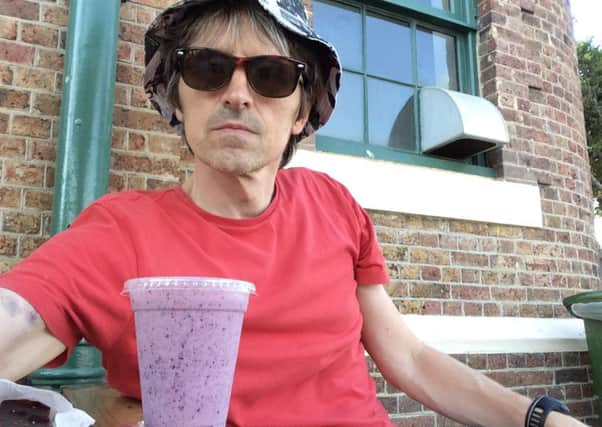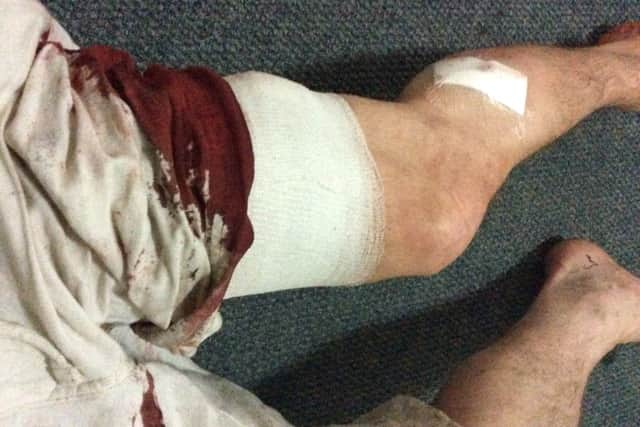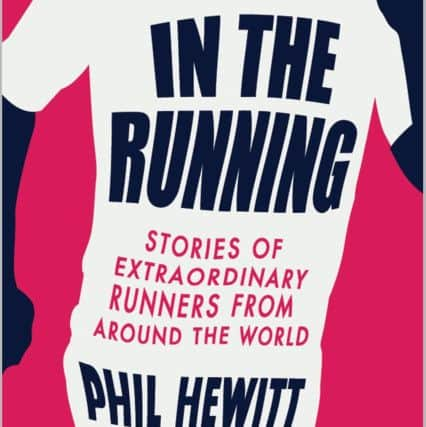'˜Editing my book helped in a time of need'


There I was, four weeks after being left for dead in Cape Town, desperately wishing Fareham precinct would swallow me up never to be seen again.
And that’s what made it so horrid. There is surely nowhere on earth less frightening than Fareham precinct.
Advertisement
Hide AdAdvertisement
Hide AdBut there I stood, trembling, desperate to disappear yet utterly incapable of moving. Slowly, deliberately, I forced myself to count to a hundred and the panic subsided. I am hugely relieved to say I haven’t yet become the odd bod who blubs in Boots. But it was a close-run thing.


I knew I had to do something drastic. And I did. I launched into my two-point recovery plan.
I wrote down absolutely every last detail, every thought and every feeling about the brutal mugging I had suffered, and the very next morning I went for a run.
And that was the beginning of my return to health… and the start of my own understanding of the book I was writing.
Advertisement
Hide AdAdvertisement
Hide AdA veteran of 30 marathons from New York to Tokyo, from Marrakech to Berlin, via Rome, London, Paris, Amsterdam, Dublin and Mallorca among others, I had been asked to write a volume about the world’s most remarkable runners.


I gave myself the deadline of completing the first draft by February when I had booked to go out to Cape Town to watch England take on South Africa at the glorious Newlands cricket ground. Deadline met, off I went.
England lost, but so what? I was in surely the world’s most beautiful ground, and I was on a high as I walked back to central Cape Town – and walked into trouble.
A few miles later, I was relieved of my camera in a tussle which saw me stabbed, punched and kicked.
Advertisement
Hide AdAdvertisement
Hide AdMy attacker fled. I couldn’t stand. Instead, I crouched by the roadside and watched the pavement turn red. I was convinced I’d had it and was fading away when a passing pizza delivery guy scooped me up and whizzed me to hospital – a fantastic guy to whom I have absolutely no doubt I owe my life.


Two stabs, 15 stitches, severely-kicked guts and several broken ribs gave way to infection, hospital stays and in the end abdominal surgery… and also weeks of blackness.
But in those dark days, I started to edit the book and found all sorts of inspiration in the runners I had described just a few weeks before, runners who had pushed their bodies to impossible lengths or who had overcome the most appalling conditions or run through the most horrible, ghastly trauma, injuries or illness – runners who had conquered much worse things than I needed to.
Then came the panic attack in Boots… swiftly followed by the realisation that I absolutely had to run again, despite the stabbed leg, however much it hurt.
Advertisement
Hide AdAdvertisement
Hide AdAnd so I did. It was horribly painful, probably medically unwise, a strange lurching/bobbing gait, a mix of Quasimodo and a duck… but something lifted mentally.


When I ran the Berlin Marathon in 2008, I was privileged to run in the same race in which the incomparable Haile Gebrselassie broke his own world record.
I will always remember that he said the most gracious, beautiful thing to the rest of us: ‘You were my tailwind and are all record-breaking runners, too!’
It was a thought I’d always cherished – and when I ran/hobbled again, I realised that the remarkable runners I was writing about were actually my tailwind in my moment of need. They helped me through – and this book has become my tribute to them.
Advertisement
Hide AdAdvertisement
Hide AdIn the book, you will find the tale of the Canadian guy who attempted to run across Canada after losing a leg to cancer; the German man who set a world record for running a marathon backwards; the New Zealand woman who set a world record, running three and a half days without sleep; the US guy who has run nearly 100 marathons since terminal diagnosis; the 100-year-old Sikh who ran a marathon; and the American who ran every day for 45 years and two days.
I have also looked at the modern greats of the sport and the pioneers of long-distance.
But my favourite remains the little-known Hyvon Ngetich, the 29-year-old Kenyan runner who collapsed about a quarter of the mile from the finishing line in the 2015 Austin Marathon. Look up what happened next on YouTube, and I defy you to do so without a little tear in your eye. She completes the course on her hands and knees.
With two metres to go, she is knocked into third place, but for me she achieved sporting greatness.
Advertisement
Hide AdAdvertisement
Hide AdOf course, you run against other people, but the noblest race is against yourself, and that’s the race she ran so beautifully. That piece of film and the stories in this book illustrate what sport actually means. And these are the people who have been in my mind as I have battered my way back to something approaching slightly-shaky health. And that’s what running has given me.
It lifts and it inspires. It repairs and it heals. It reconnects and it reconstructs.
And in a busy world in which everything crowds in on you, in which everyone seems to be chasing you for something, running is the best way to reclaim something incredibly precious, maybe the most precious thing of all: our sense of our own freedom.
Certainly, in the midst of trauma, pain, infection, hospitalisation and surgery, running was the only thing that made me feel like me again. In The Running is a celebration of the spirit which makes us run.
A celebration of the spirit to run
Advertisement
Hide AdAdvertisement
Hide AdIn The Running is published in paperback by Summersdale, priced £9.99; ISBN: 978 1 84953 886 2.
The book offers a celebration of running pushed beyond the limits of normal human endurance.
Tales include:
n Cliff Young, the 61-year-old Aussie farmer in galoshes who beat the world’s elite in the 875-km Sydney-to-Melbourne ultramarathon.
While they slept at night, he simply kept going all the way to the finishing line, a modern-day tortoise amid the hares.
Advertisement
Hide AdAdvertisement
Hide Adn Jane Tomlinson, the inspirational Leeds mum who raised millions as she battled cancer.
n Theresa Giammona, who eventually ran the New York City Marathon in place of her husband, a firefighter and keen runner killed on 9/11.
In The Running is Phil’s 10h published book, a successor to his popular 2012 Keep On Running, the tales of his own marathons around the world.
Phil, of Bishop’s Waltham, is group arts editor for The News’ West Sussex sister papers.